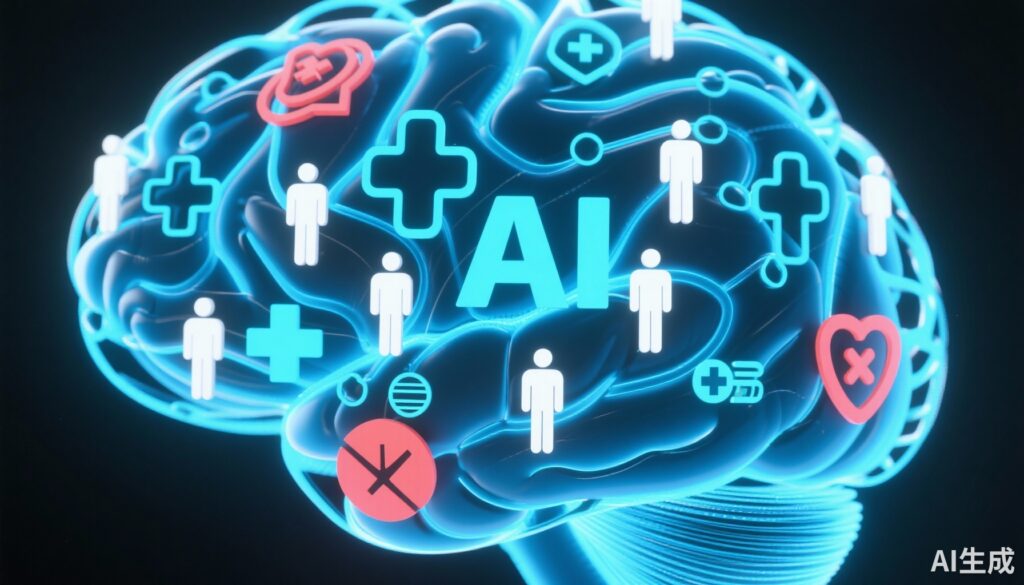Introduction: A New Era of Predictive Medicine
Imagine knowing your future health risks decades before symptoms appear—enabling targeted prevention and timely interventions. This vision moves closer to reality with Delphi-2M, an innovative artificial intelligence (AI) model that predicts an individual’s risk of more than 1,000 diseases up to twenty years in advance. Developed by a multinational research team and recently published in Nature (“Learning the natural history of human disease with generative transformers”), Delphi-2M adapts techniques from GPT language models to “read” human disease history like a language, forecasting disease trajectories with accuracy comparable to specialized clinicians.
How Delphi-2M Reads the Language of Disease
Traditional clinical risk calculators typically estimate the chance of developing one or two diseases, using broad inputs like age, blood pressure, or cholesterol. Delphi-2M revolutionizes this by treating a person’s medical timeline as a sequence of “tokens”—each token representing an event such as contracting influenza at a certain age, pregnancy, or receiving a diabetes diagnosis, along with demographic and lifestyle factors like sex, body mass index (BMI), smoking, and drinking habits.
To capture temporal dynamics, researchers replaced standard position encoding (used in language models to understand word order) with “age encoding,” enabling Delphi-2M to predict not just what the next disease might be, but when it might occur. After training on over 100 million data points from 400,000 individuals in the UK BioBank, the model learned the “syntax” of diseases—understanding which illnesses tend to co-occur, and which ones serve as critical endpoints (akin to sentence periods).
One Second, One Thousand Risk Reports: Personalized and Dynamic Prediction
Delphi-2M provides a detailed “daily incidence rate” prediction for each of over 1,000 diseases within one second, far surpassing traditional calculators limited to single-disease risk estimation. The model can update its predictions dynamically as new laboratory or clinical data become available.
Evaluation against traditional clinical risk scores, such as QRISK3 (for cardiovascular disease) and Framingham Risk Score, showed that Delphi-2M achieved an area under the receiver operating characteristic curve (AUC) between 0.8 and 0.97 for many high-impact events including death, sepsis, and breast cancer—indicating very high predictive accuracy. Moreover, when externally validated on a cohort of 1.9 million Danes, the model’s performance dropped minimally by only 2%, demonstrating remarkable generalizability across populations.
From Real to Virtual Lives: The Power of Synthetic Medical Histories
One of Delphi-2M’s most striking features is its ability to “write” completely synthetic life histories that closely mimic real disease distributions. Researchers asked the model to extend existing medical records for 60,000 individuals from age 60 onward for the next 20 years, and the predicted population-level incidence rates aligned closely with observed real-world data.
Furthermore, Delphi-2M generated 400,000 entirely synthetic life histories from birth. Training new models on this synthetic data resulted in only a 3% decrease in predictive power. This breakthrough suggests that future research may leverage such anonymized synthetic datasets to accelerate medical discovery without compromising patient privacy.
Opening the AI Black Box: Transparency and Trust
AI models are often criticized for opacity, but Delphi-2M breaks new ground by mapping diseases onto a “semantic map” where proximity indicates strong comorbidity relationships. For example, various forms of diabetes cluster together, as do heart attacks, sepsis, and death.
Using SHAP (SHapley Additive exPlanations) interpretability methods, clinicians can see which parts of a patient’s medical history contributed most to a heightened risk prediction. In one instance, the model identified key preceding conditions increasing pancreatic cancer risk by 19-fold. Such transparency empowers doctors to understand, trust, and act on AI-generated insights rather than treating them as black-box verdicts.
Challenges and Ethical Considerations: Beware Data Biases
Despite its promise, Delphi-2M replicates biases inherent in its training data. The UK BioBank recruits individuals aged 40–70 who tend to be wealthier and predominantly white. Consequently, the model underestimates risks for minority ethnic groups and economically disadvantaged populations, and tends to miss diseases primarily recorded in outpatient or community settings.
The research team stresses that before clinical deployment, data gaps must be addressed, population structures recalibrated, and strict regulatory reviews conducted to prevent exacerbating health disparities or causing harm.
Looking Forward: Towards Multimodal Health Models
Currently, Delphi-2M relies mainly on ICD-10 diagnostic codes and limited lifestyle variables. The research team envisions integrating genomics, laboratory tests, imaging scans, and wearable device data to build comprehensive “multimodal” health models.
In the future, AI may interpret raw clinical notes and images to refine predictions further. Imagine an AI that not only says, “Your 5-year heart attack risk is 3%” but also combines genetic predispositions, cardiac MRI results, and daily step counts to recommend personalized lifestyle or medication adjustments—such as whether to start statins, schedule coronary CT angiography, or increase daily walking goals.
Case Scenario: Meet Sarah, a 45-Year-Old Woman
Sarah, a busy marketing manager, provides her past medical history to a healthcare platform powered by Delphi-2M. She reports having contracted influenza twice in childhood, mild asthma as a teenager, current BMI of 28, occasional smoking in early adulthood, and borderline high cholesterol.
Within seconds, the AI generates Sarah’s personalized risk report, highlighting a slightly elevated 10-year risk of coronary artery disease and type 2 diabetes. It also reveals modifiable factors—such as quitting smoking and improving cholesterol—and suggests relevant screenings. Over the next decade, as Sarah’s lab tests and health behaviors update in the system, the AI recalculates risks, enabling her physician to tailor preventive interventions precisely.
Redefining Healthcare: From Reactive to Proactive
Delphi-2M ushers in an era where health risks are quantifiable, trackable, and actionable—shifting medical care from treating established disease to preventing future illness. This AI acts like a continuous “health weather forecast,” alerting individuals and clinicians to upcoming risks based on comprehensive data.
While AI will not replace the nuanced judgment and empathy of physicians, it will become an indispensable tool to enhance precision medicine and reduce disease burden.
Conclusion
Delphi-2M represents a milestone in leveraging generative transformers for patient-centered disease prediction, capable of forecasting more than 1,000 conditions with clinical-grade accuracy. Its ability to generate synthetic patient histories offers promising avenues to bypass privacy constraints inherent in medical data sharing. Achieving equitable, multimodal models that incorporate diverse data types and populations will be key to unlocking its full potential.
As AI-powered tools become integrated into healthcare, they will enable earlier interventions, personalized recommendations, and ultimately shift us towards a future of preventative, precision medicine that empowers individuals like Sarah to take control of their health decades before illness strikes.
References
1. Alaa, A.M., et al. Learning the natural history of human disease with generative transformers. Nature (2025). https://www.nature.com/articles/s41586-025-09529-3
2. Hippisley-Cox, J., et al. Predicting cardiovascular risk in England and Wales: QRISK3. BMJ (2017)
3. D’Agostino, R.B., et al. General cardiovascular risk profile for use in primary care: the Framingham Heart Study. Circulation (2008)
4. Lundberg, S.M., Lee, S.-I. A unified approach to interpreting model predictions. Advances in Neural Information Processing Systems (2017)


